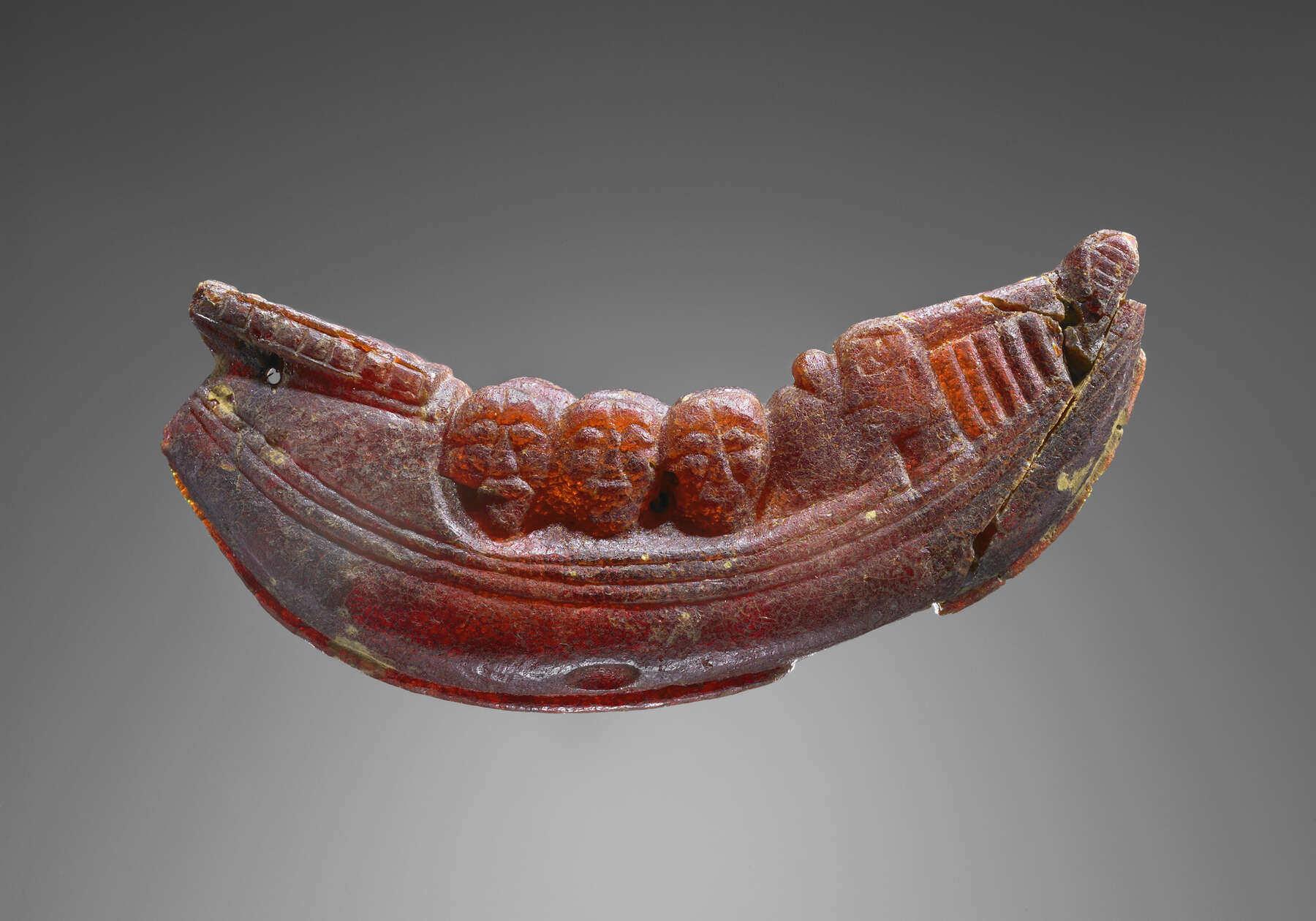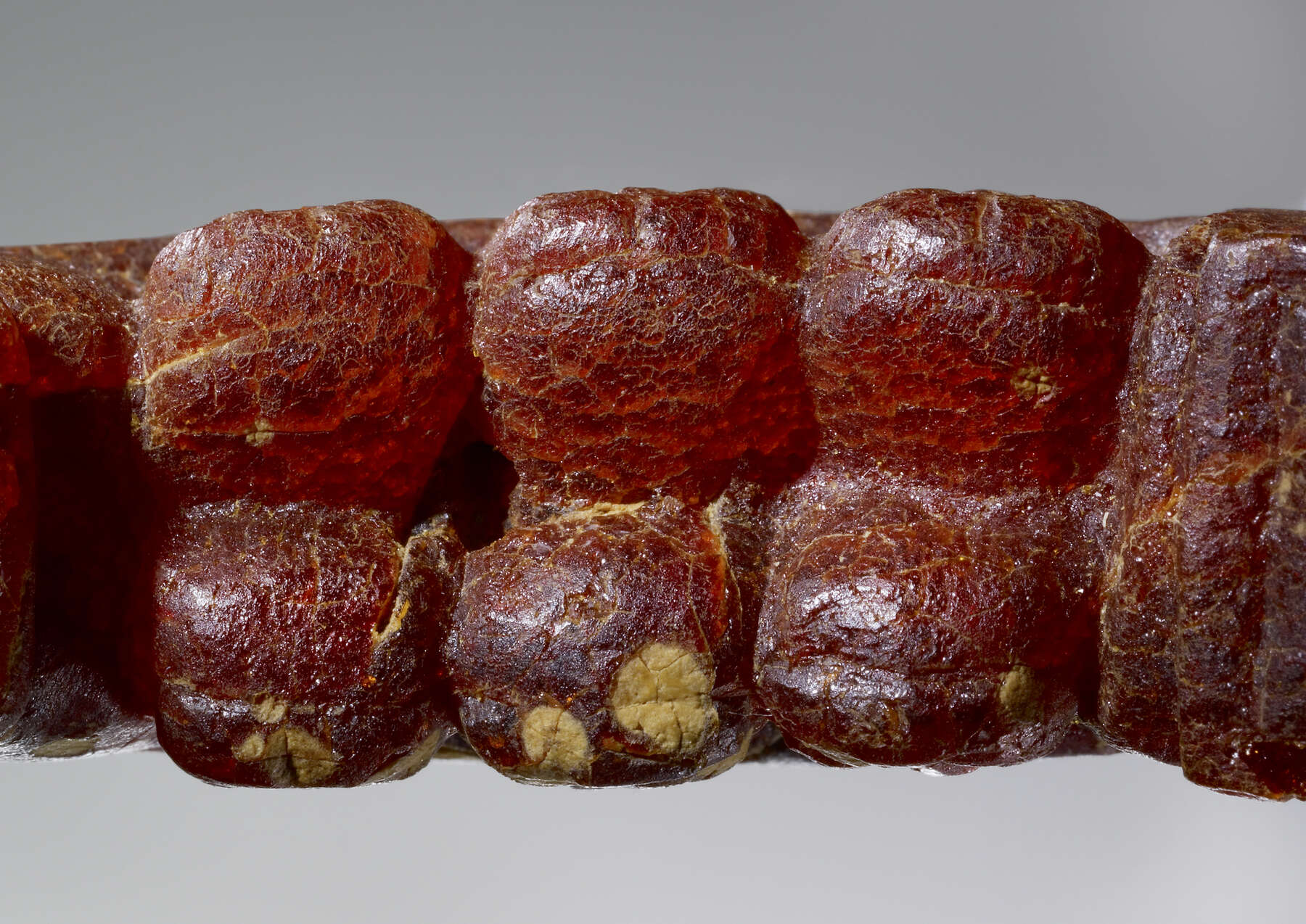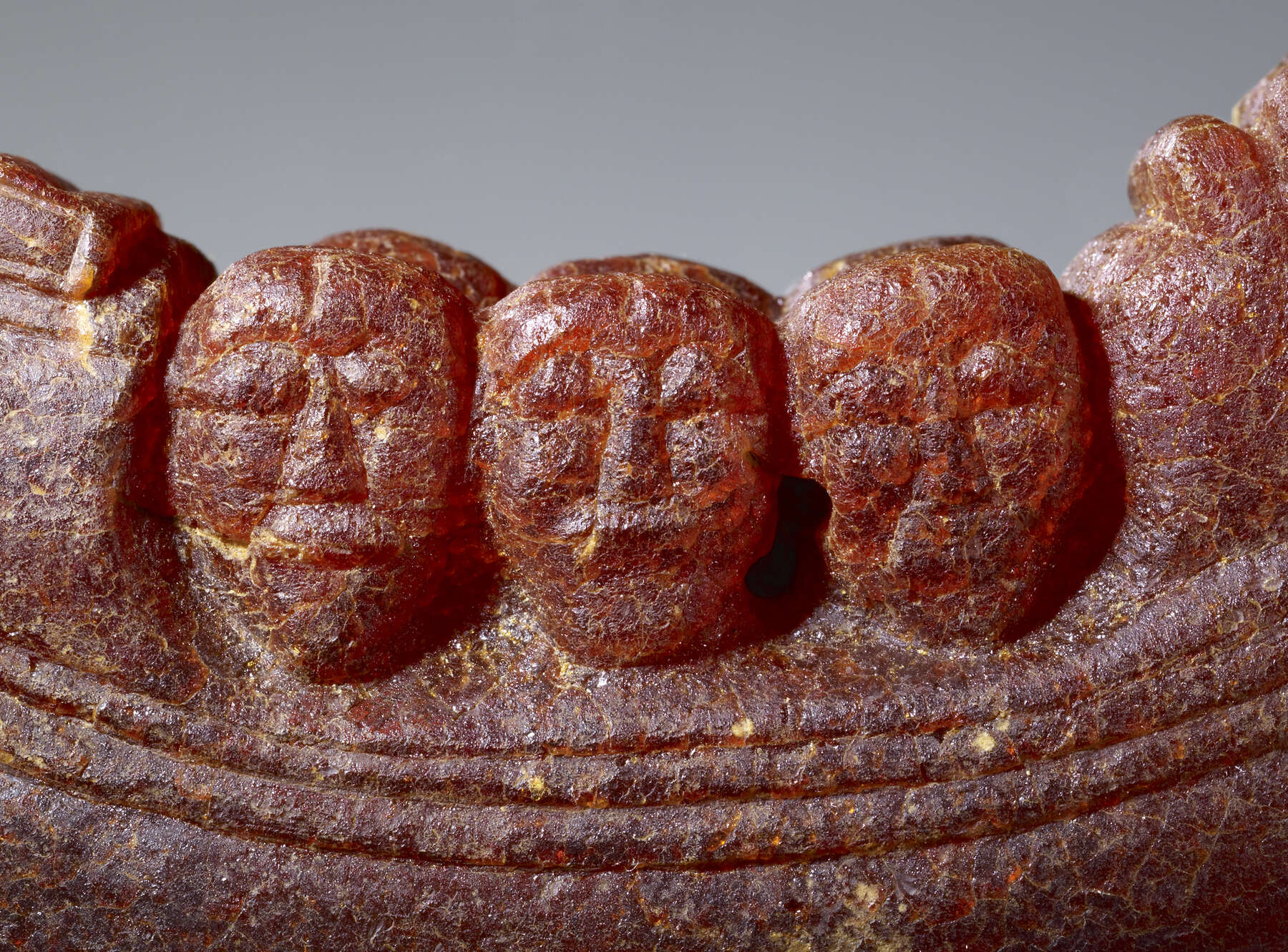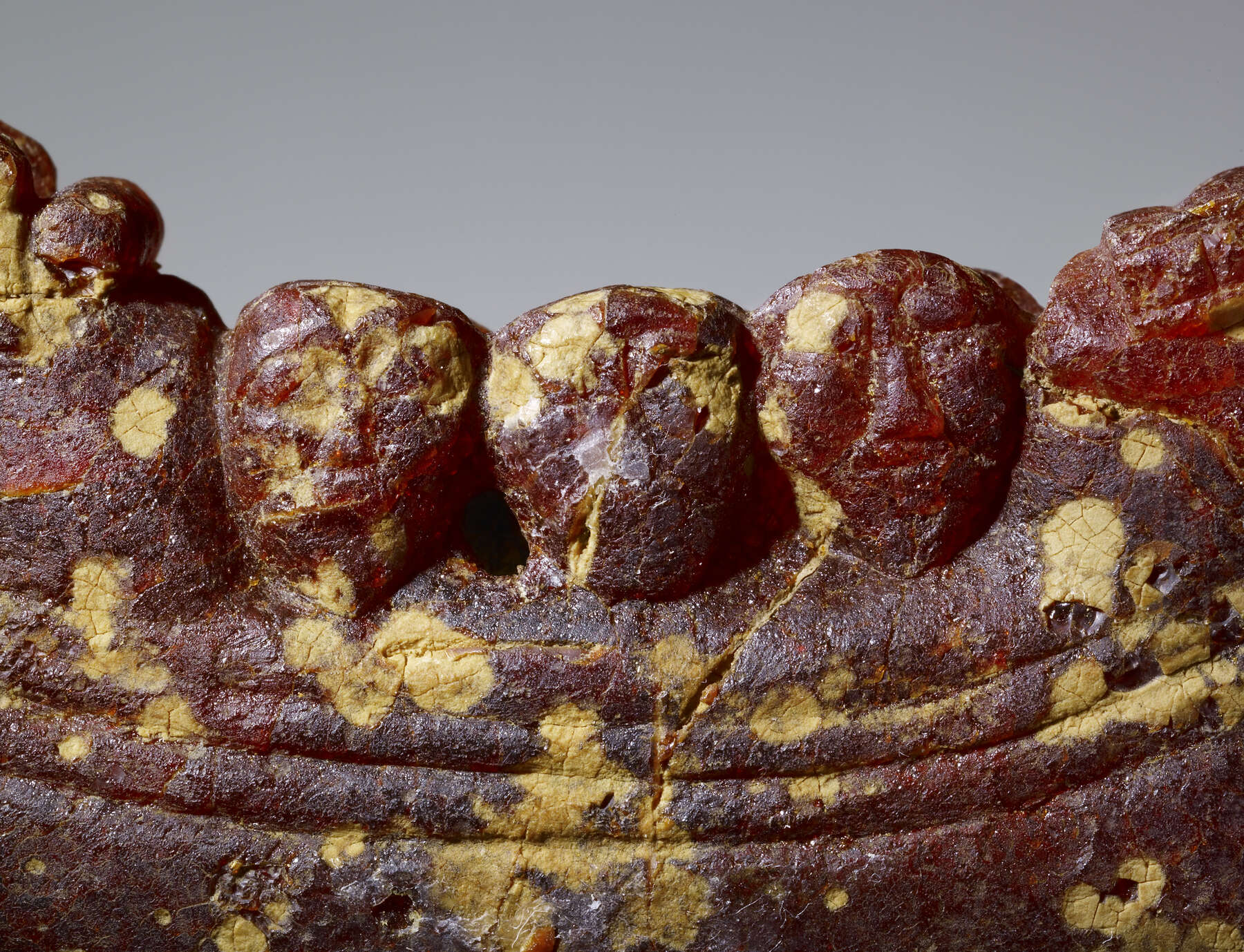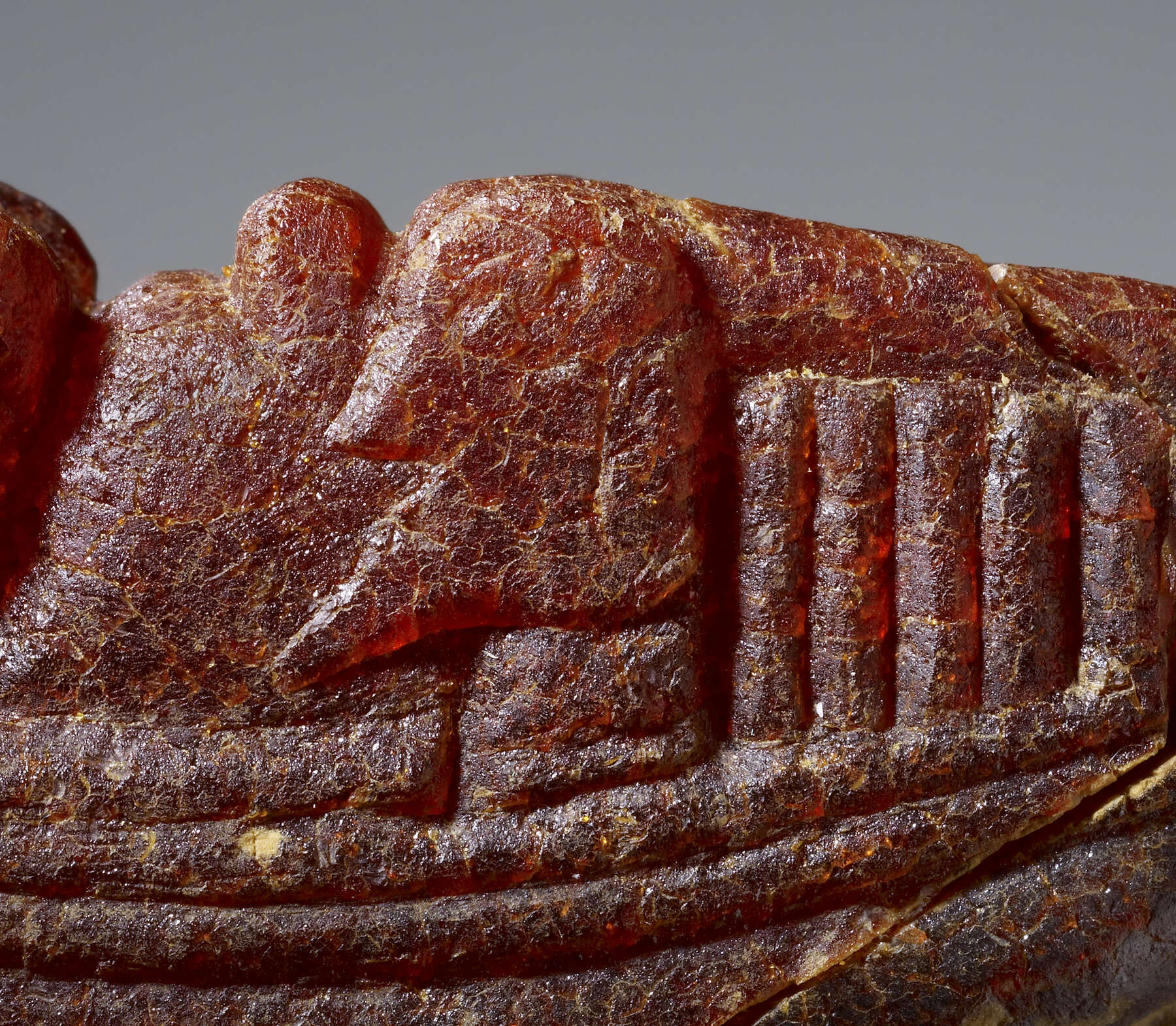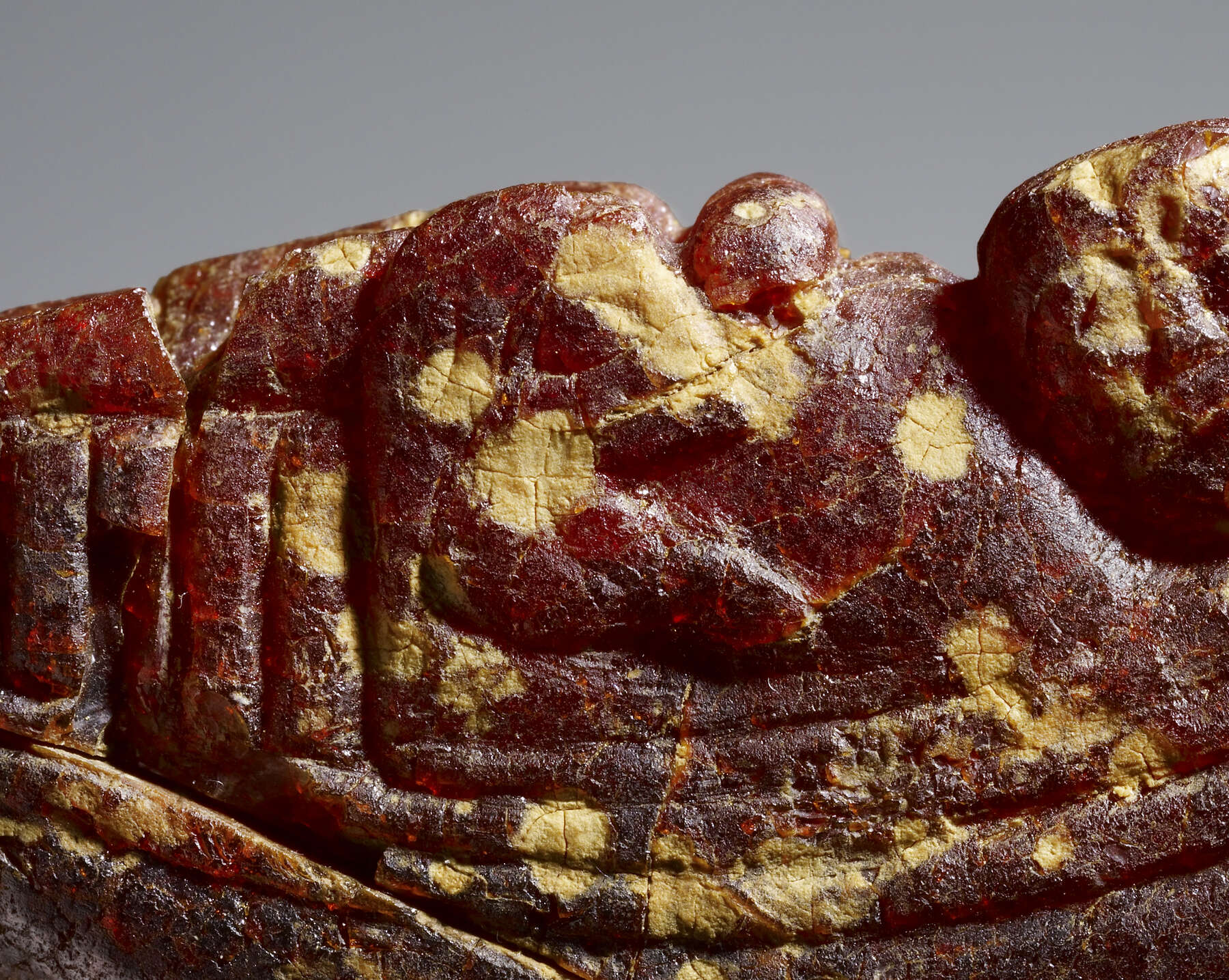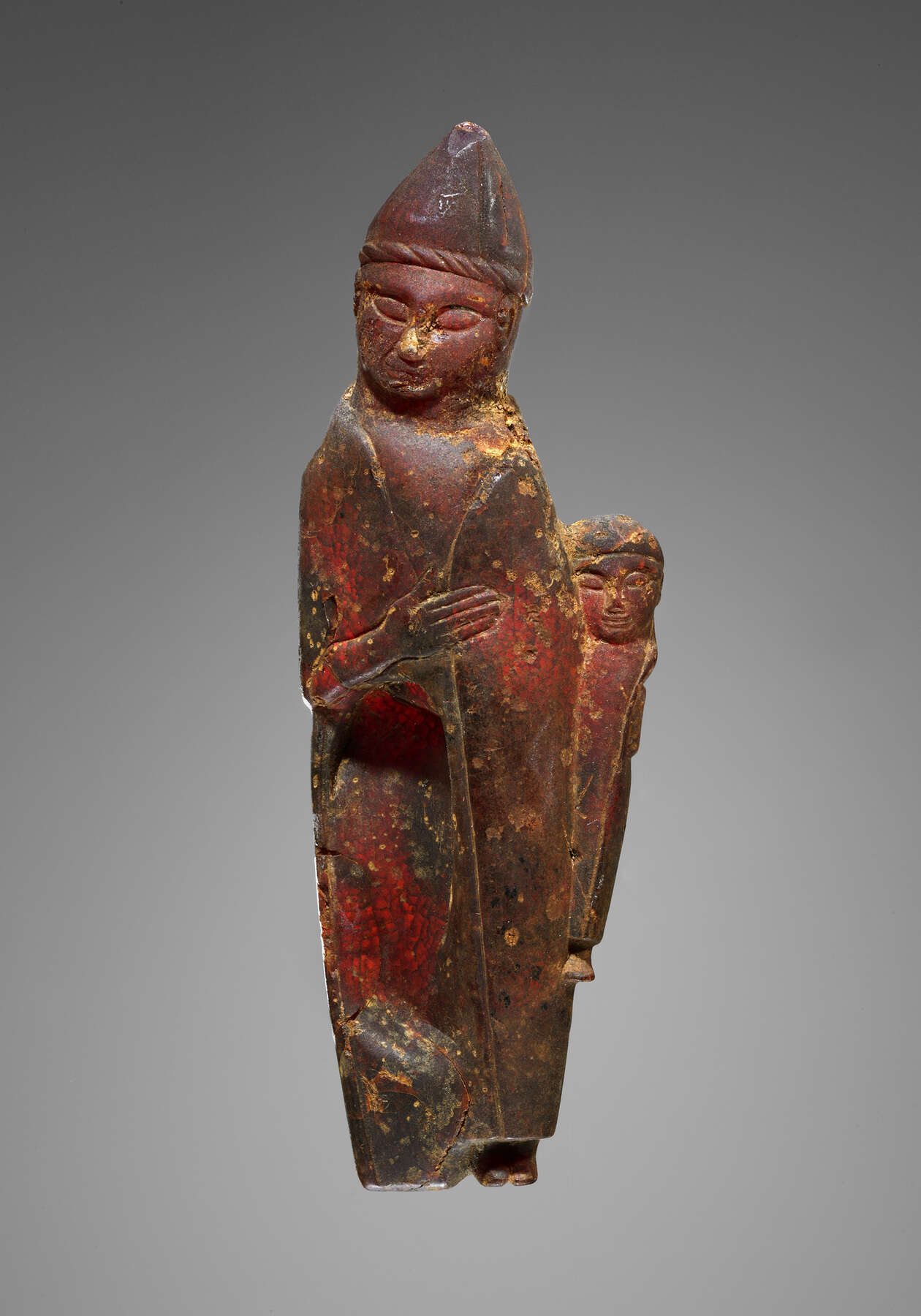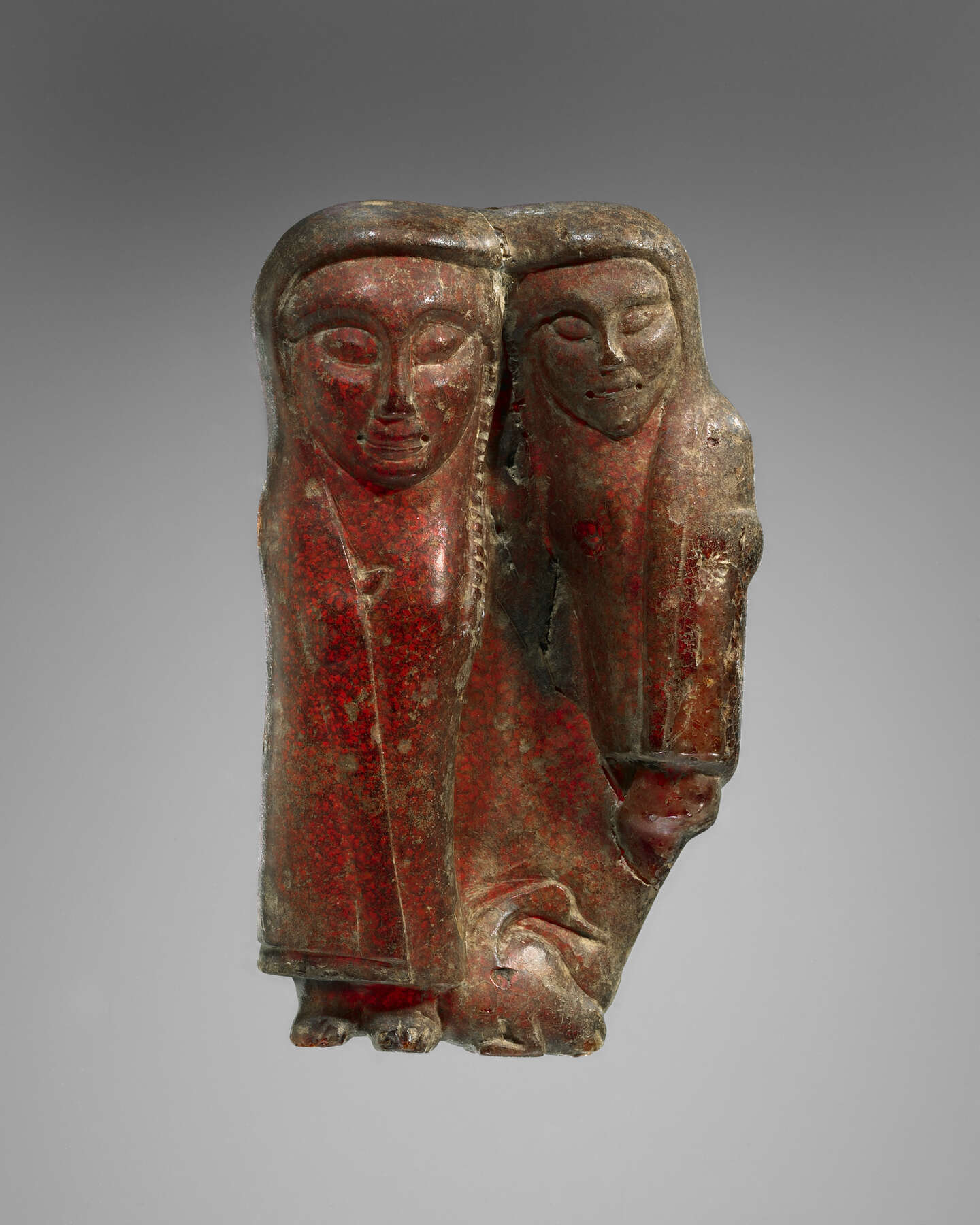7. Pendant: Ship with Figures
| Accession Number | 76.AO.76 |
| Culture | Etruscan |
| Date | 600–575 B.C. |
| Dimensions | Length: 120 mm; width: 35 mm; depth: 10 mm; Weight: 66 g |
| Subjects | Funerary use of amber (also Burial); Jewelry; Magic |
Provenance
–1976, Gordon McLendon (Dallas, TX), donated to the J. Paul Getty Museum, 1976.
Condition
There is a break at the bow, a large chip in this break, a break at the bow set of suspension holes, and a number of small chips on the top side. A section of the keel is broken off, and there is an old fracture loss on the starboard side just above the keel. There are large fissures on the top, port, and starboard sides near the stern. The crazing is uniform overall.
The object is dark reddish brown in ambient light and translucent and dark reddish orange in transmitted light. There are a number of inclusions (or, possibly, deterioration pittings) throughout the piece, mostly on the port side.
While in the donor’s collection, the piece was lightly cleaned and the two broken sections of the bow reattached.
Description
The pendant is worked fully in the round. The ship has a deeply rounded hull and a heavy keel. At one end, identified here as the stern, is a curved, knoblike protrusion that must be the aphlaston, or sternpost, which is shaped like a schematic bird-head device. In front of the aphlaston is a raised structure, probably the stern castle, articulated on its sides by five parallel vertical indentations, with a division down the center on the top, and uneven protrusions (the sheet and cordage?). At the bow, in front of the figures, is an undifferentiated section of amber and, above it, a rectangular form that protrudes over the bow. This forward structure, a bow screen, or possibly a flexible upper deck, is described by two narrow horizontal fillets within which are short vertical incisions; on its top, it is marked off with transverse parallel lines. Seven figures are aboard ship. On each side are three figures, represented by their frontal heads and necks. On each side is carved the profile of a long-haired, bearded man (head, neck, and a small section of the torso are represented); in front of him is a tied sack or other cargo. This figure sits in front of the stern castle and looks forward.
The six outward-facing figures are nearly identical. They have similarly shaped oval faces, centrally parted caplike hair, and cursorily modeled features. Their eyes are almond-shaped, blank, and bulging; their noses are triangular; and their mouths are formed as parallel bars. The bearded figure sits taller in the ship and is slightly larger in scale than the frontal figures. His almond-shaped eyes are set high in his face. He has a sharp, triangle-shaped nose, a prominent pointed beard, and long hair falling over his ears to the back hairline.
The pendant preserves evidence of its original form and its preparation before the figuration. Portside is a smoothed depression, and on the bottom is a smoothed lacuna in the keel. Three sets of through-bores perforate the pendant, at the bow, at the stern, and amidships between two of the passengers’ necks. Each set forms a triangle: one hole perforates the body of the pendant from obverse to reverse, and the other two holes intersect this transverse bore at the exits. The latter two holes are drilled at an acute angle and meet at the topside of the piece, forming an apex. A filament or cord would have run from the apex of the triangle through the transverse bore and back up to the apex.
Discussion
There is no close parallel for 76.AO.76; only one other related amber carving is known, a ship with sailors from Padula (Lucania), which likely served as the bow of a fibula (see below). 76.AO.76 is generally related in style to the ambers discussed in cat. nos. 1–6 and was included in the same donation.
The shape of the pendant links it to a much older type of ornament, the crescent-shaped necklace, found in metal and amber, a fashion that flourished in the north and in Western Europe during the Beaker period and the early Bronze Age.1 The form, materials, and symbolism of such pectorals were exclusive to high-status individuals. The pendant is also related to the engraved decoration of ships on two Daunian stone stelae of females.2
76.AO.76 may be “located” in Etruria (with debts to Greek art) and dated by the compact format of the carving and the style. The frontal figures (whether passengers, sailors, or marines) are related to the Getty Kourotrophos group— (cat. no. 1) and (cat. no. 2)—and share many sculptural comparisons. The ship’s frontal figures are akin to the Etruscan bronze votives in Emeline Richardson’s Swordsman Series A, which she dates to the early sixth century B.C.3 A work such as the male sphinx acroterium from Poggio Civitate (Murlo) of about 575 B.C. also helps to place it.4 76.AO.76 gives evidence of its connection to Etruscan art when compared to seventh-century ivories and caryatid figures from bucchero chalices.5 The seated figure’s profile is similar to that of Aristaios in the Spartan ivory plaque in London, and in its silhouette and harsh modeling is generally comparable to a variety of Etruscan works dating to between the late eleventh and mid-sixth centuries: some of the early male “canopic” heads from the Chiusi area, the limestone cinerary urn in the form of a seated man from Chiusi, and profile warrior heads in bucchero.6 The ivory pyxis from Pania, Chuisi, of circa 620–580 B.C., likely carved in southern Etruria,7 offers up important analogues for both frontal and profile heads and for the schematic illustration of the ship. However, there are differences: the unbearded figure of the Pania ivory is alone in the ship and handles double rudders (and his cargo consists of two amphorae). The ivory, bronze, impasto, and bucchero objects not only suggest an approximate date for 76.AO.76, but also suggest where in Etruria it may have been made and buried.
The ship of 76.AO.76 has many earlier and contemporary comparisons in the archaeological remains and in the art of the ancient Mediterranean, especially among small three-dimensional representations in terracotta, bronze, and other materials, carved stone reliefs, Etruscan wall painting, and most particularly Greek vase painting. The subject also figures on coins and gems. The Etruscan shipwrecks at Giglio, Antibes, Marseilles, and Pisa offer extraordinary information about the actual vessels. Taken together, the corpus of ancient material allows a very particular knowledge of ships and ancient seafaring, even though in the images “some elements of the ship’s architecture [may be] telescoped, others expanded or otherwise exaggerated, while others [may be] disproportionately small or ignored entirely.”8
The Getty ship is a different kind of vessel from that represented on the Pania pyxis. The Getty amber clearly represents a rounded hull but has no oars, oarlocks, or holes. It must be one in a class of merchantmen, or cargo-carrying ships, which the Greeks called a holkadikon ploion or holkas (towed ship)—that is, a vessel dependent on masts and sails to propel it. Unequipped with oars, the holkas would have been towed into and out of harbor.9 Although the carver of 76.AO.76 has provided much detail about the ship (aphlaston, keel, stern castle, etc.), much is not indicated: there is no rudder, mast, sail, or cordage. Certainly, there were limits set by the form of the amber blank. As noted in the description, the lumpy material aft may be the stowed mast and sailing gear; alternatively, if the carriers extending from each of the three suspension points were joined up, they would form the schema of a mast and lines. The three sets of suspension holes would have enabled the pendant to hang from three separate points or to be attached to clothing or another, larger ornament, in three places. Then again, a carrier attached at each point might have been pulled up to a central point above the pendant, the lines of the carriers then forming a bisected triangle—a pattern like that of a mast and lines. With the pendant suspended this way, the rails would be parallel to the horizon, very like the position of a ship at sea.
Another important ship comparison is an ivory pectoral decoration from the sanctuary of Artemis Orthia at Sparta,10 whose scene is perhaps a disembarkation. The subject has been interpreted as the carrying off of Helen to Troy.11 Both ornaments are lunular in shape, with just a few figures.
There is only one other published amber in the form of a ship, from a burial at Padula, Lucania. First published by Amadeo Maiuri in a short, illustrated note in 1914, it was found along with numerous other objects during roadwork in the early twentieth century. Maiuri identified the disturbed find as the remains of a woman’s grave.12 While the Padula amber ship is generally similar to the Getty ship in subject, size, shape, suspension technique,13 degree of relief carving, and the absence of a mast, they differ in artistic style, type of ship, characterization of the figures, and implied narrative.
The Padula ship is an oared galley with a dolphin-figured forefront or ram. Stowed nautical equipment—mast, sail, and cordage—is visible at the top on the starboard side and above and behind the figures on the port side. Aboard are four figures facing aft and a single figure facing forward. Only the upper parts of each figure are represented; all are in profile. The figure astern has a rudder (perhaps one of a pair). The two sides of the Padula amber are dissimilar. To port, only two of the sailors are fully indicated. To starboard at the prow is a large shield, the blazon of which is an eagle in flight to the left.
The Padula amber is generally similar to the Getty ship and calls to mind the same stylistic comparisons. The Padula pendant compares well with many early-to-mid-sixth-century B.C. objects, including Greek vases. This proposed early date is commensurate with that of the other amber objects illustrated by Maiuri, especially bulla-shaped amber pendants, which were popular throughout much of the Italian peninsula from the early seventh century. This ship amber, too, may have been carved in Etruria, perhaps in a southern Etruscan center such as Cerveteri.
The two ship pendants present many questions: why a pendant with a ship subject, for whom were they made, why were they buried in a grave (as is assumed for 76.AO.76), and once there, how did they work? The ship (with and without sailors) has a long history of funerary use, from early Egypt as well as Old Europe. The amber ships may have had a comparable function in tombs as that of ship models, wall paintings with ships, and vases decorated with ships (some with figures and some without).14 The Tarquinian tombs with ships, the Tomb of Hunting and Fishing and the Tomb of the Ships, underline the high status of such imagery. The carving of ships with sailors on two Daunian stelae of women opens up many questions, some first posed by M. L. Nava.15 Do these represent objects, such as pendants? Are they part of the dress? And what role does such prominent imagery play for the deceased individuals?
Although it is probable that the Getty pendant, like the Padula amber, was unearthed from a grave, both pendants may have had similar previous quotidian functions. If this is so, we might ask on what occasions or for what reasons the pendants were worn. The Getty pendant and the Padula ship offer no evidence of wear.
It is possible that the original forms of the amber lumps informed the imagery—that is, the form of the raw amber determined which kind of ship would be represented, and the narrative followed. If the ship imagery symbolizes the same thing, it was surely augmented by amber’s magical aspects. It is conceivable that there was always a connection of amber with sailing, and with particular ships and voyages, real or legendary, which inspired the formation and embellishment of the raw material into these pendants.
Amber’s natural buoyancy in saltwater may be one of the simplest explanations for the choice of a marine subject. The ship may represent, in a general sense, journey by sea, sea trade, or colonization. In the Archaic period, a successful sea journey held the promise of incredible wealth, but it was also a dangerous and risky undertaking. A ship-shaped amber pendant may have had a direct talismanic function. Was it a charm that brought good luck and good sailing?16 A ship as an amuletic subject could also represent the “vehicle” on which danger could be sent away. A curse against a night-wandering demon commands, “Go away upon swift ships!”17
On the other hand, did this portafortuna once promise success in trading ventures or in the establishment of a colony? It must have been the elite who sent abroad trading ships, themselves symbols of status and prestige. A ship could also stand for some of the values of aristocratic society, such as the entrepreneurial spirit or the Odysseus-like cleverness and ingenuity that was required on dangerous journeys to unknown places. Successful marine enterprises, whether for business or for the establishment of colonies, contributed to the self-definition of the aristocrat. Figures such as Odysseus became Leitbilder for Greek and Etruscan aristocrats traveling far from home.18 Owning, wearing, giving, or being given an object like the Getty ship pendant might offer or affirm an identity with Odysseus, might articulate a colonial Greek, Etruscan, or Italiote’s ethnic identity, or might even affirm a genealogical connection to Odysseus. At the least, because the pendants are made of amber, they can be seen as objects of high-status material embellished or reinforced with an inherently high-status subject.
The ship ambers are also open to more concrete epical and mythological readings. Some of the relevant Greek stories are Theseus’s voyage to Crete, Jason and the Argonauts’ search for the Golden Fleece, and Odysseus’s adventure with the sirens. There is a close connection between the Argonauts and amber. In one of the amber-origin stories, the Argo sailed up the Eridanus River and the Argonauts came upon the body of water in which Phaethon had fallen. A Homeric subject might have had a particular relevance for an amber amulet. Homer’s words were magical. “Quotations from his work could heal people when whispered in their ears or hung around their necks written on amulets, which should be preferably of gold.”19 Odysseus in particular was a magical figure, for he had survived transport within a mystically powerful, precivilized natural world; he went to locales where the heavens seemed to touch the land and sea, places between the celestial and earthly realms.20
Odysseus’s challenge to the sirens had particular resonance in southern Italy: sirens ranged along the Tyrrhenian coast, and their home was an island offshore (perhaps real, perhaps mythical), or perhaps they were turned into rocks after their suicide.21 The bearded figure of 76.AO.76 could depict Odysseus or perhaps the captain. The omission of Odysseus may have functioned as an intentional ellipsis; the wearer could symbolically replace the hero.
Another story known from the Odyssey that deserves our consideration—and one not, to my knowledge, previously associated with surviving images in Greek and Etruscan art—is an episode of Menelaus’s Return. The bearded helmsmen of each pendant might, from this perspective, have been associated with Phrontis, the helmsman of Menelaus, “whom no man has yet surpassed in piloting a ship when storm winds blast.” This is how, in the Odyssey, the horseman Nestor pays tribute to Phrontis, who was struck by Apollo “with his gentle shafts” as the ship bearing Menelaus and Nestor neared Sunium, the sacred headland, “while his hand held fast the steering rudder.” “So Menelaus, although he was keen to journey on, stopped then at Sunium to bury and to honor his companion.”22 Menelaus’s Return was one of the subjects painted by Polygnotos in a section of his murals in the Knidian Lesche at Delphi. Pausanias singled out the figure of Phrontis in his long ekphrasis of the Lesche program as “the only one with a beard,” and, interpreting Homer’s words, he added, “Menelaus was left behind to build Phrontis a tomb and to pay him the due rites of burial.”23 Certainly, a depiction that would recall Homer, Menelaus’s Return, and Nestor would have carried strong associations with burial, honor, and magic and might even have been a compelling reason for the choice of subject and for the subsequent burial in the tomb of an elite personage—even if that personage were a woman.
In this regard, it is useful to recall the gold votive inscription from the coastal sanctuary at Pyrgi, which mentions “Uni/Astarte, Ino/Leukothea, and Eileithyia[,] all mother goddesses who were supposed to help mortal women in childbirth and watch over the growth of young children, as well as save sailors.”24
Both the Getty and Padula ships may allude to the barque of the sun.25 If there is a solar connection, the object may be linked to Bronze Age illustrations of the solar journey, the metaphor for rebirth,26 and to a unique Etruscan depiction of the sun barque (with three passengers) sailing eastward, above the solar god driving his horses, on a mirror from Orbetello (Museo Archeologico Nazionale, inv. MA 73798). One part of the route to the resting place of the dead was over the sea, to a place “which evoked an occidental archipelago of the blessed, an Afterworld beyond the ocean, in the sector belonging to the netherworld’s gods,” as Jean-René Jannot writes, and it is “a sea monster or a ship of the high seas” that brings the dead to the other shore.27 Such a vision of the afterworld may owe much to the Bronze Age in northern Europe, the source of the amber.
Notes
- L. Casson, Ships and Seamanship in the Ancient World (Princeton, 1971), p. 2. This was brought to my attention by J. Bouzek and E. Pleslová-Štiková. For an overview of the type, see E. Pleslová-Štiková, “A Crescent-Shaped Necklace from Velvary, Bohemia,” in , pp. 147–52. A crescent necklace was the attribute of a high-ranking individual; the finds of amber and metal examples, and the representations of them on engraved anthropomorphic stelae, establish the early date. ↩
- Museo di Manfredonia 0806: M. L. Nava in , p. 221, fig. 2, no. III.230. ↩
- , pp. 64–70; compare, for example, Arezzo 11490, 11492, 11493, 11495 (ibid., pls. 24–31); and Volterra 18, 23, 24, 28 (ibid., pls. 29–32). ↩
- Poggio Civitate, Antiquarium 68–100. ↩
- Compare, for example, the pair from the Tomb of the Animals at Cerveteri (Rome, Museo Nazionale Etrusco di Villa Giulia S10V3: , pp. 302–5, no. 420); and the two female figures from a large ivory find from Comeana in Florence (Museo Archeologico Nazionale 194541–42: ibid., p. 260, nos. 318–19a). ↩
- The ivory plaque showing Aristaios in the British Museum (GR 1954.9–10.1) is possibly from the sanctuary of Artemis Orthia at Sparta; the Chiusine limestone urn (of circa 540–520 B.C.) is British Museum GR 1847,1127.1. For the Chiusine canopus urns, see . ↩
- Florence, Museo Archeologico Nazionale 73846, from a plundered chamber tomb in the Pania necropolis, Chiusi. See , p. 85, figs. 34–35, with earlier bibl., including Y. Huls, Ivoires d’étrurie (Brussels, 1957), pp. 62–63, 165–68, pls. 27–29; and M. Cristofani, “Per una nuova lettura della pisside della Pania,” 39 (1971): 2ff. , pp. 110–11, concludes that it was “probably imported from Southern Etruria, not made in Vulci or Cerveteri as has been proposed. It is probable that the artist who carved the friezes drew for his models on Greek painted pottery, particularly Corinthian.” ↩
- S. Wachsman, Seagoing Ships and Seamanship in the Bronze Age Levant (College Station, TX, 1997), p. 198. ↩
- Casson 1971 (in n. 1, above), p. 169, nn. 2–3. In addition to Wachsman 1997 (in n. 8, above), critical bibl. for this entry includes F. Kaul, Ships on Bronzes: A Study in Bronze Age Religion and Iconography, Publications from the National Museum, Studies in Archaeology and History (Copenhagen, 1998); L. L. Walker, “A Study of Minoan Ships in Prehistoric Aegean Art,” master’s thesis (Queen’s University at Kingston, 1996); and K. Westerberg, Cypriote Ships from the Bronze Age to c. 500 B.C. (Copenhagen, 1983). ↩
- For this seventh-century B.C. Laconian pectoral, “Helen Led to the Ship,” see , pp. 83–90, no. 38, fig. 68. ↩
- Ibid., p. 90. ↩
- A. Maiuri, “Avanzi di suppellettile d’una tomba preromana,” 11 (1914): 403–6. The Padula furnishings included a number of small amber pieces, including parts of fibula decorations, beads and pendants of several types, fragments of bronze sheets decorated in repoussé (one possibly a pendant), and fragments of ceramics. The ship pendant, the bulla-shaped amber pendants, and the plain beads of the grave may have belonged to one or more pieces of body ornamentation, including earrings, necklaces, pectorals, armlets, pins, girdles, and clothing decoration. ↩
- Both were drilled with three sets of perforations, one set each at the bow, at the stern, and amidships. Three separate filaments could have been secured at the three perforation sets, then joined at a point above for attachment to a carrier, fibula, or girdle. ↩
- The two amber ships are as different in type as the unmanned vessels painted on an early-seventh-century B.C. Italo-Geometric oinochoe, the manned pair engraved on an eighth-century B.C. fibula from Sparta, or the two painted on one side of the “Aristonothos krater” from Cerveteri (Rome, Capitoline Museums 172). The last’s two ships are variously interpreted: some scholars identify one as Greek and the other as Etruscan, Phoenician, or Italic. Whether consciously made to represent Greek versus non-Greek, or whether there are just two types of ship actually engaged in battle, the krater may have a function as a grave good similar to that of the amber ship-shaped carvings. For the Italo-Geometric oinochoe with ships and fishes in the University of Missouri (Columbia) Museum of Art and Archaeology (71.114), see , p. 556, no. 50, with bibl. For the Spartan fibula, see J. W. Hagy, “800 Years of Etruscan Ships,” International Journal of Nautical Archaeology and Underwater Exploration 15, no. 3 (1986): 221–50. For the krater, see C. Dougherty, “The Aristonothos Krater: Competing Stories of Conflict and Collaboration,” in The Cultures within Ancient Greek Culture: Contact, Conflict, Collaboration, ed. C. Dougherty and L. Burke (Cambridge, 2003), pp. 35–56; M. Torelli, “The Encounter with the Etruscans,” in , pp. 567–76; and L. Basch, Le Musée imaginaire de la marine antique (Athens, 1987). ↩
- See n. 2, above. ↩
- Amulets with ship images of later date are documented as having special powers. G. Kornbluth, Engraved Gems of the Carolingian Empire (University Park, PA, 1995), says, “One Byzantine text describes how [a Palestinian pilgrim’s] token was used during a winter storm and ‘all those on the boat were impregnated with perfume, the sea water surrounded the boat like a wall, and the waves were powerless against it.’” The agate used in one ship-subject gem was believed to be especially protective for sailors. The use of the Middle Low German word Bernstein for such a stone seems entirely plausible, although there is no evidence for this. ↩
This much-discussed iambic chant (written down by the second-century Festus, his source the first-century Verrius Flaccus) is revisited by , pp. 386–87, in reference to her study of aversion rituals against child-killing demons. What she finds unusual is the command to go away on a ship.
↩Rituals from the old, middle, and new Babylonian periods … attempted to send Lamashtu away by means of a ship, a donkey or both. The rituals involved dedication of small clay ships and/or donkeys to a statuette of Lamashtu, as well as provisions and gifts such as malt, food, water, spindles, sandals, fibulae and combs, which were supposed to keep her happy on her journey. Some ritual texts tell her to use the ship to go across the river, which may mean the river that separated the land of the living from the land of the dead in Mesopotamian thought, or go across the sea. (p. 386)
- T. Hölscher, “Immagini mitologiche e valori sociali nella Grecia arcaica,” in Im Spiegel des Mythos: Bilderwelt und Lebenswelt / Lo specchio del mito: immaginario e realtà; Symposium, Rom, 19.–20. Februar 1998, ed. F. de Angelis and S. Muth (Wiesbaden, 1999), pp. 11–30. ↩
- S. Sande, “Famous Persons as Bringers of Good Luck,” in , p. 233. Sande refers to C. A. Faraone, “Taking the ‘Nestor’s Cup Inscription’ Seriously: Erotic Magic and Conditional Curses in the Earliest Inscribed Hexameters,” Classical Antiquity 15 (1996): 83–85. ↩
- , p. 467; , chap. 2. ↩
- Sirens are a popular subject of amber pendants dating from the Early Archaic period onward, becoming one of the most common subjects by the end of the fifth century B.C. For discussion of sirens in amber, see the introduction, in particular “The Archaic and Afterward.” ↩
- Odyssey 3.276–85 (A. Mandelbaum, The Odyssey of Homer: A New Verse Translation [Berkeley, 1990], p. 51). ↩
- Pausanias 10.25.2–3 (Description of Greece, trans. W. H. S. Jones IV [Cambridge and London, 1935], p. 513). ↩
- , p. 183. ↩
- The dismantled mast and the furled sail may have special meaning; compare the composition of 76.AO.76 to the Egyptian hieroglyph of a ship without a furled sail (Gardiner’s Sign List no. 48). Among its functions, it means “to sail downstream.” In Egypt, the solar boat is a subject of magical amulets. ↩
- Kaul 1998 (in n. 9, above). ↩
- , p. 62. ↩
Bibliography
- Ambre 2007
- Ambre: Trasparenze dall’antico. Exh. cat. Naples, 2007.
- Bartoloni et al. 2000
- Bartoloni, G., et al., eds. Principi etruschi: Tra Mediterraneo ed Europa. Exh. cat. Bologna, 2000.
- Beck and Bouzek 1993
- Beck, C. W., and J. Bouzek, eds. Amber in Archaeology: Proceedings of the Second International Conference on Amber in Archaeology, Liblice, 1990. Prague, 1993.
- Gempeler 1974
- Gempeler, R. D. Die Etruskischen Kanopen: Herstellung, Typologie, Entwicklungsgeschichte. Einsiedeln, Switzerland, 1974.
- Haynes 2000
- Haynes, S. Etruscan Civilization: A Cultural History. Los Angeles, 2000.
- Helms 1993
- Helms, M. W. Craft and the Kingly Ideal: Art, Trade, and Power. Austin, TX, 1993.
- Helms 1988
- Helms, M. W. Ulysses’ Sail: An Ethnographic Odyssey of Power, Knowledge, and Geographical Distance. Princeton, 1988.
- Jannot 2005
- Jannot, J.-R. Religion in Ancient Etruria. Translated by J. Whitehead. Madison, WI, 2005.
- Johnston 1995
- Johnston, S. I. “Defining the Dreadful: Remarks on the Greek Child-Killing Demon.” In Ancient Magic and Ritual Power, edited by M. Meyer and P. Mirecki, pp. 361–87. Leiden, 1995.
- Jordan et al. 1999
- Jordan, D. R., H. Montgomery, and E. Thomassen, eds. The World of Ancient Magic: Papers from the First International Samson Eitrem Seminar at the Norwegian Institute at Athens, 4–8 May 1997. Bergen, 1999.
- Marangou 1969
- Marangou, L. Lakonische Elfenbein- und Beinschnitzereien. Tübingen, 1969.
- Pugliese Carratelli 1996
- Pugliese Carratelli, G., ed. I Greci in Occidente. Exh. cat. Venice, 1996. Published in English as The Greek World: Art and Civilization in Magna Graecia and Sicily. New York, 1996.
- Richardson 1983
- Richardson, E. H. Etruscan Votive Bronzes: Geometric, Orientalizing, Archaic. 2 vols. Mainz am Rhein, 1983.
- Sprenger and Bartoloni 1981
- Sprenger, M., and G. Bartoloni. The Etruscans: Their History, Art and Architecture. Translated by R. E. Wolf. Milan, 1981.
- Torelli 2000
- Torelli, M., ed. Gli Etruschi. Exh. cat. Venice, 2000. Published in English as The Etruscans. Milan, 2000.
